Brewster H.D. Fluid Mechanics
Подождите немного. Документ загружается.


162
oP
=0
OXl
oP
Hydrostatics and Aerostatics
OX2
= -pg(sin a -
~,
cos
a)
cos a
oP
OX3
=
-pg[l
- (sin a -
~r
cos
a)
sin a].
Thus the solution corresponding to the equation reads:
p = C - pg[(sin a
-~,
cos
a)
cos
a]x
2
-
pg[l-(sin a -
~,
cos
a)
sin a]x3'
If
one puts on the one hand P =
Po,
for the free surface, one obtains the
equation for the plane in which the free surface
lies.
When one takes further
into consideration,
that
the origin
of
the coordinates lies again
on
the free
surface, i.e.
C =
Po'
one obtains as final equation:
[
(sina-~r
cosa)cosa
]
x = - X2'
3
l-(sina-~rcosa)sina
r
9
b
Fig. Treatment
of
the '''fluid
flows'"
in a rotating
vertically moved and partly filled cylinder
For
this general case
of
"friction-loaded motion" along the inclined
plane
of
the fluid container, a free liquid surface appears which
is
less
inclined when compared to the horizontal plane
than
the inclined plane.

Hydrostatics and Aerostatics
163
Attention
has
to
be paid, however,
to
the fact
that
the derivations only
hold when
Ilr
~
tan
u.
For
Ilr~
tan
u one obtains the limiting case
of
a container
at
rest i.e. the
frictional force
is
higher then the forward accelerating force.
As
a last example
to
show the employment
of
hydrostatic laws in
accelerated reference systems.
It
shows a rotating cylinder closed
on
the
top
and
at
the bottom, which
is
partly filled with a liquid.
When
the
cylinder
is
at
rest,
the
free surface
of
this liquid assumes a
horizontal position, as the different liquid particles only experience
the
gravitational force as mass force. When the cylinder
is
put
into rotation, one
observes a deformation
of
the liquid surface which progresses until as a final
form paraboloid. When now on this rotating motion an additional accelerated
vertical motion
is
superimposed, one detects that the hyperboloid can assume
different
shapes, depending
on
the magnitude
of
the vertical acceleration
and
on
the direction in which it takes place.
In
the following it shall be shown
that
the issue
of
the shape
of
the hyperboloid can be answered
on
the basis
of
the
basic equations
of
hydrostatics.
For
this purpose a coordinate system
is
chosen,
which
is
firmly coupled
to
the walls
of
the rotating
and
vertically accelerated
cylinder
and
which thus experiences the rotating motion as well as the
accelerated vertical motion.
The above mentioned examples have shown
that
the hydrostatic basic
equations are applicable, provided
that
no fluid motion occurs in the chosen
coordinate system
and
that
the external acceleration forces
are
taken into
consideration as inertia forces.
It
is
shown
that
for the following derivations the horizontally occurring
centrifugal acceleration
co
2
r,
as well as the '''vertical acceleration'" b, have
been taken into account.
If
one considers the processes in the fluid body in a coordinate system
(r,
<p,
z),
rotating with the cylinder, one finds that all fluid particles are
at
rest
after having reached the stable final state
of
motion. With reference
to
the
chosen coordinate system the prerequisite for the employment ofthe hydrostatic
basic equation
is
fulfilled, which in cylindrical coordinates
adopt
the form
indicated below:
ap
lap
ap
ar
=
pgr
; ;-
a<p
=
pgq>;
az
=
pg=
.
For
gr
=
rco
2
,
gq>
= 0
and
gz
=
-(g
+ b) one obtains for the problem
to
be treated the following set
of
basic equations
and
their general solution.
ap
2 1 2 2
-a =prco
~
P=-pcor
+jj(<p,z)
,
r 2
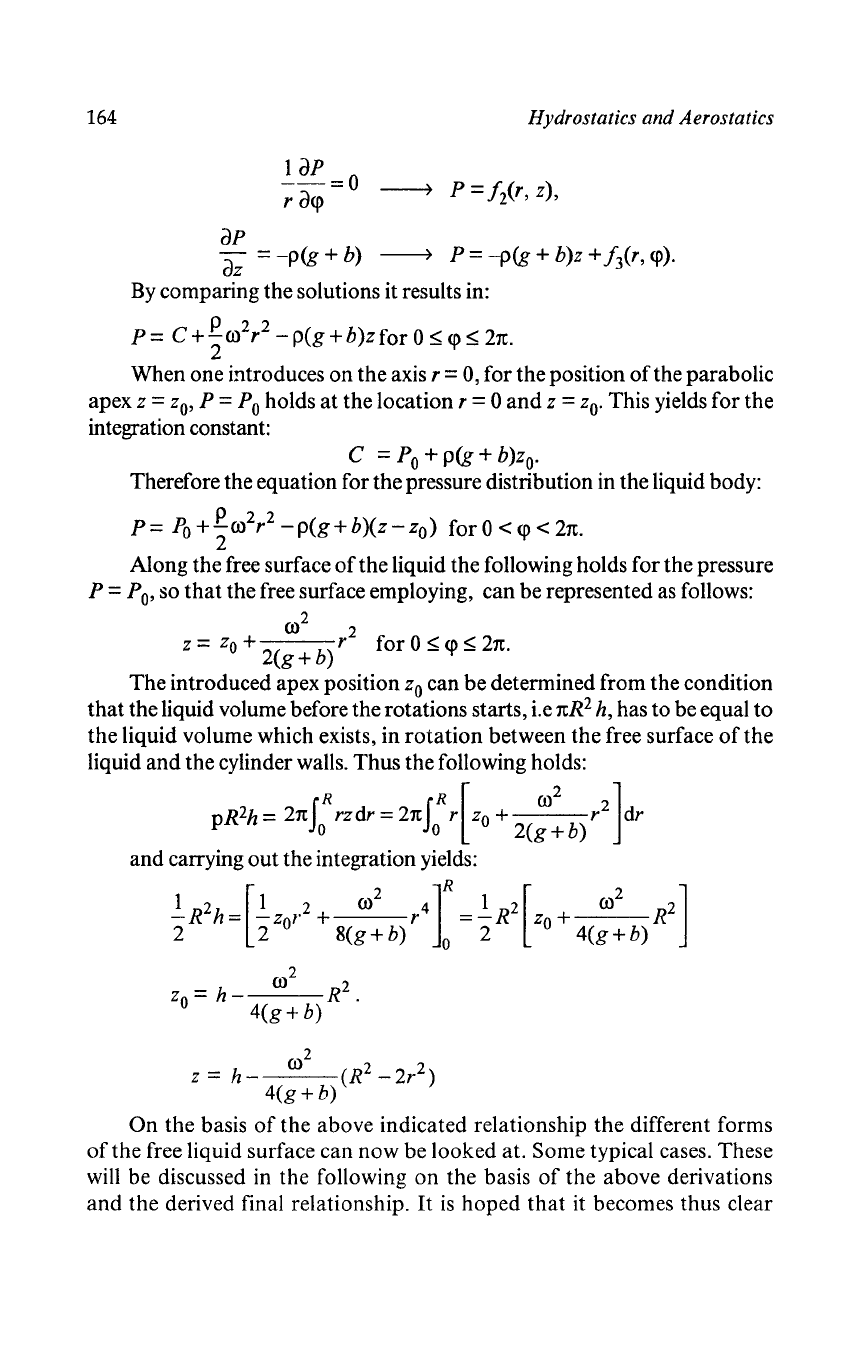
164
Hydrostatics and Aerostatics
ap
- =
-peg
+ b)
-----7
P =
-peg
+ b)z + 1
3
(r,
q».
az
By
comparing the solutions it results in:
p 2 2
P=
C+2"O)
r
-p(g+b)zforO~q>$;2n.
When one introduces on the axis r = 0, for the position
of
the parabolic
apex
z =
zo'
P =
Po
holds
at
the location r = 0
and
z =
zoo
This yields
for
the
integration constant:
C =
Po
+
peg
+ b)zo·
Therefore the equation for the pressure distribution in the liquid body:
p 2 2
P=
Po
+2"0)
r
-p(g+b)(z-zo)
for 0 <
q>
< 2n.
Along the free surface
of
the liquid the following holds for the pressure
P =
Po'
so
that
the free surface employing, can be represented
as
follows:
0)2 2
z =
Zo
+ 2(g +
b>,
for
0
~
q>
~
2n.
The introduced apex position
Zo
can be determined from the condition
that
the liquid volume before the rotations starts, i.e nR2
h,
has to be equal
to
the liquid volume which exists, in
rotation
between
the
free surface
of
the
liquid and the cylinder walls. Thus the following holds:
pR2h =
2n
i
R
rzdr =
2n
i
R
r[zo + 0)2
r2]dr
o 0
2(g+b)
and carrying out the integration yields:
!R
2
h=[!Z,.2
+ 0)2
r4]R
=!R2[z
+
0)2
R2]
2 2 0 8(g + b) 0 2 0
4(g
+ b)
0)2
Zo
=
h-
R2.
4(g+ b)
2
Z = h _
0)
(R
2
_
2r2)
4(g+ b)
On
the basis
of
the
above indicated relationship the different forms
of
the free liquid surface can now be looked at. Some typical cases. These
will
be discussed in the following on the basis
of
the above derivations
and
the derived final relationship.
It
is
hoped
that
it becomes thus clear

Hydrostatics and Aerostatics
165
for
the reader how physical information can be
obtained
by
derivations
on
basic equations
of
fluid mechanics e.g. the form
of
the free surface
of
a liquids in containers can be calculated.
b>-g
b=-g
_
b<-g
Fig. Examples of Possible Forms
of
the Fluid Surface
in
a Rotating Vertically Accelerated Cylinder
The
positions
of
the liquid surface indicated in Figure can be stated
by the indicated relationship in the relative magnitudes
of
band
g:
b >
-g
: When the vertical acceleration
of
the container takes place
upwards and the resultant
b points downwards, respectively, with 0 > b >
-g,
the '''opening
of
the parabola'"
is
positive according
to
equation. The liquid
touches the bottom
and
side areas
of
the container.
b =
-g:
When
the
vertical acceleration
of
the container takes place
downwards with
b =
-g,
the entire fluid rests
at
the side wall
of
the container.
b <
-g
: When the vertical acceleration
of
the container takes place all
downwards with b <
-g,
the "opening
of
the parabola"
is
negative according
to
equation. The fluid touches the ceiling
and
side areas
of
the container this
can be taken from equation.
COMMUNICATING
CONTAINERS
AND
PRESSURE-MEASURING
INSTRUMENTS
Communicating Containers
In
many fields
of
engineering one has
to
deal with fluid systems
that
are
connected
to
one another by transverse pipelines. Special systems are those in
which the fluid
is
at rest,
i.e.
in which the fluid does
not
flow. Figure represents
schematically such a system which consists
of
two containers with "fluids
at
rest"
that
are connected with one
another
by a pipeline with a valve.
When the valve
is
opened, both these systems can interact with one another
in such a way
that
a flow takes place from the container with higher
pressure
at
the entrance
of
the communication line
to
the container with
lower pressure. When this balancing flow fails to materialize, the same
fluid pressure exists on
both
sides
of
the tap, i.e. it holds:
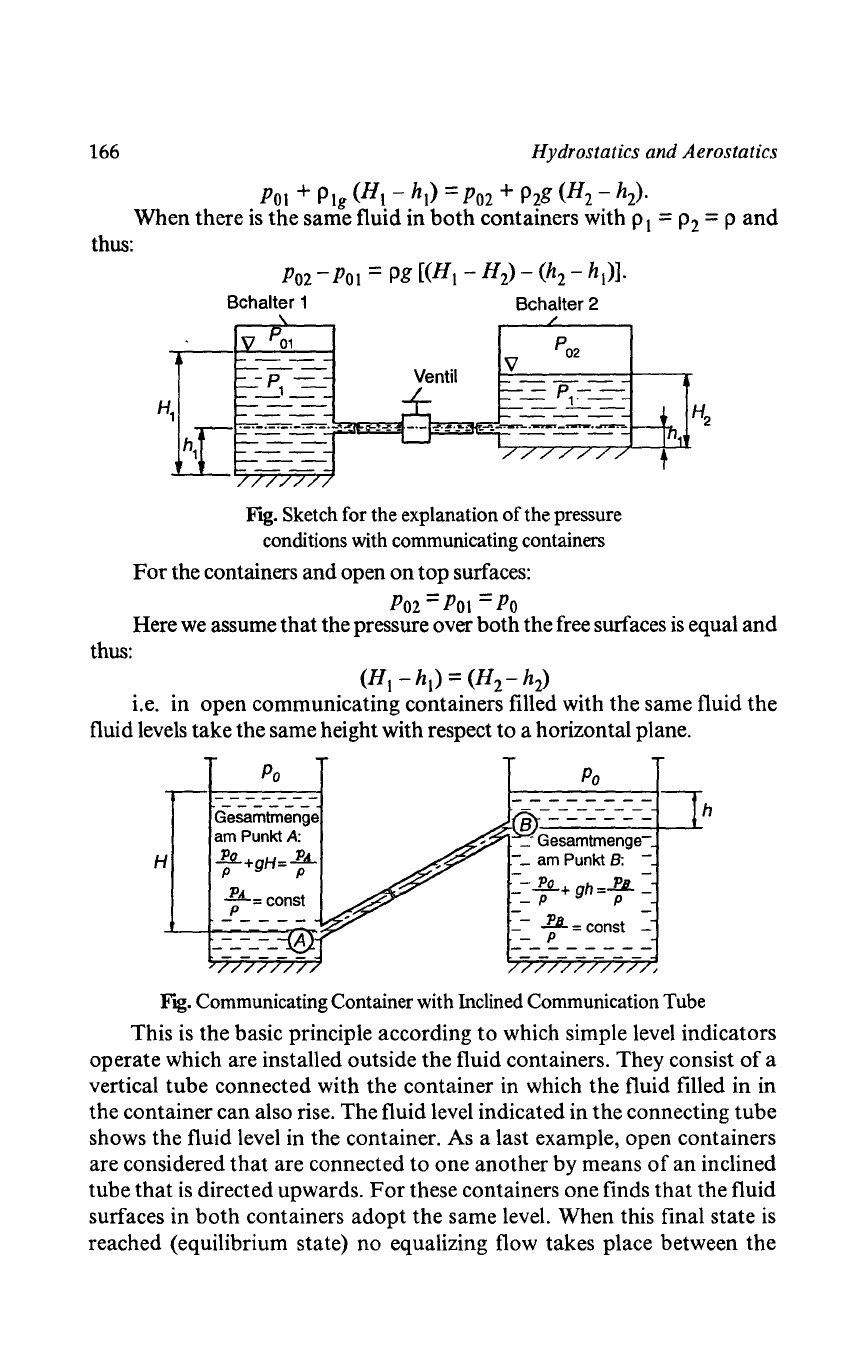
166
Hydrostatics and Aerostatics
POI
+ Pig (HI - hi) =
P02
+
P2g
(H2 - h
2
)·
When there
is
the same fluid in
both
containers with
PI
=
P2
= P
and
thus:
thus:
Bchalter 1
-p
-
_1-=-
Bchalter 2
Ventil
Fig. Sketch for the explanation
of
the pressure
conditions with communicating containers
For
the containers and open on top surfaces:
P02
=
POI
=
Po
Here
we
assume that the pressure over both the free surfaces
is
equal and
(HI -
hi)
= (H2 - h
2
)
i.e. in open communicating containers filled with the same fluid the
fluid levels take the same height with respect to a horizontal plane.
Po
Po
-------
--------
------
h
Gesamtmenge
@~~:~:~~~~:=
am
PunktA:
H
k+
gH
=.1?L
-_am
Punkt
B:
-
p p
::::-
k+
gh=.J!L
::::
J!.L= const
- P P
P
-
.J!L=
const
-
-
-
-
-
p
--------
Fig. Communicating Container with Inclined Communication Tube
This
is
the basic principle according
to
which simple level indicators
operate which are installed outside the fluid containers. They consist
of
a
vertical tube connected with the container in which the fluid filled in in
the container can also rise. The fluid level indicated in the connecting tube
shows the fluid level in the container. As a last example, open containers
are considered
that
are connected
to
one another by means
of
an inclined
tube that
is
directed upwards.
For
these containers one finds that the fluid
surfaces in
both
containers adopt the same level. When this final state
is
reached (equilibrium state) no equalizing flow takes place between the
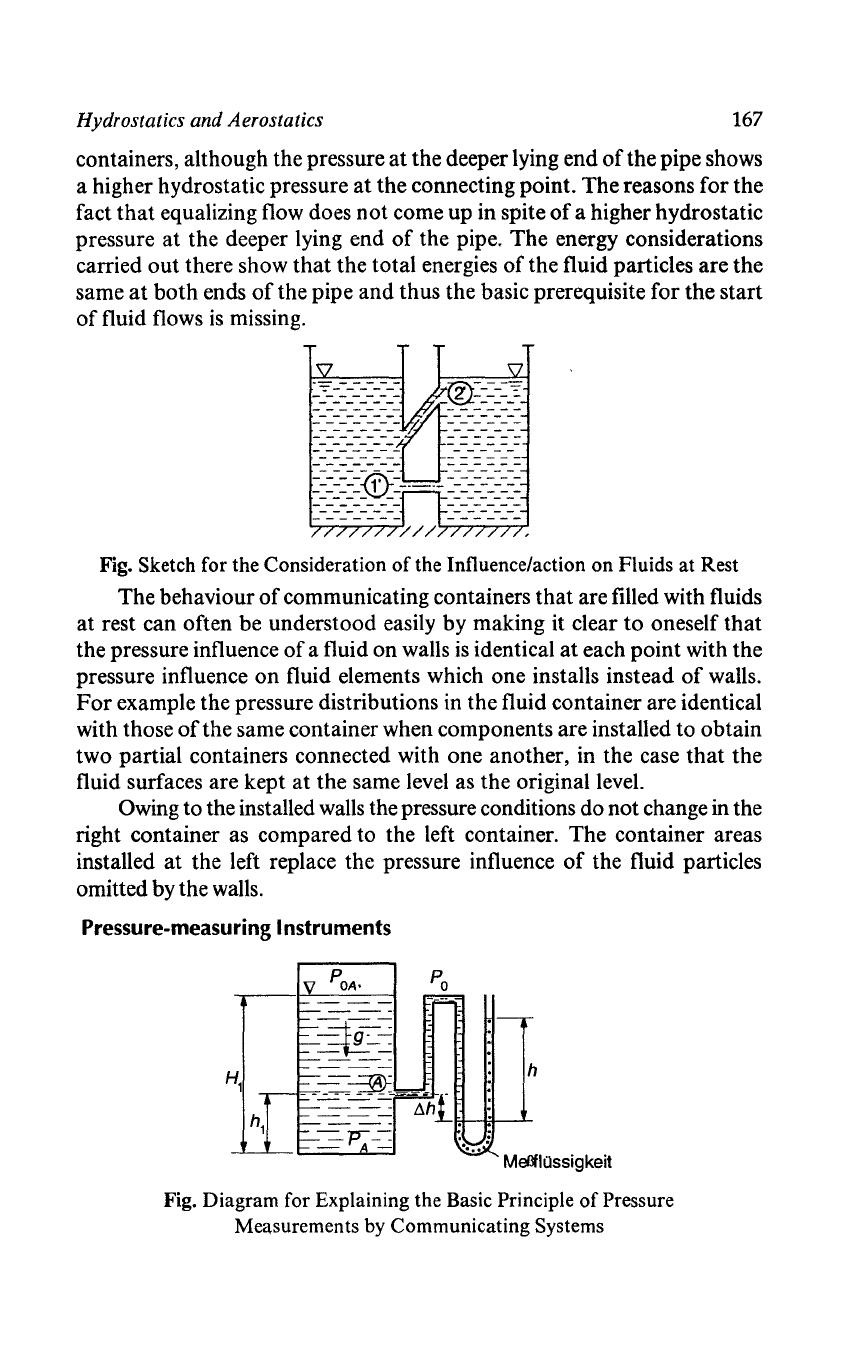
Hydrostatics and Aerostatics
167
containers, although the pressure
at
the deeper lying end
of
the pipe shows
a higher hydrostatic pressure
at
the connecting point. The reasons for the
fact
that
equalizing flow does not come up in spite
of
a higher hydrostatic
pressure
at
the deeper lying end
of
the pipe.
The
energy considerations
carried
out
there show
that
the total energies
of
the fluid particles are the
same
at
both
ends
of
the pipe and thus the basic prerequisite for the start
of
fluid flows
is
missing.
Fig. Sketch for the Consideration
of
the Influence/action on Fluids at Rest
The behaviour
of
communicating containers that are filled with fluids
at rest can often be understood easily by making it clear
to
oneself
that
the pressure influence
of
a fluid on walls
is
identical
at
each point with the
pressure influence
on
fluid elements which one installs instead
of
walls.
For
example the pressure distributions in the fluid container are identical
with those
of
the same container when components are installed to obtain
two partial containers connected with one another, in the case
that
the
fluid surfaces are kept at the same level as the original level.
Owing to the installed walls the pressure conditions do not change in the
right container as compared to the left container. The container areas
installed at the left replace the pressure influence
of
the fluid particles
omitted by the walls.
Pressure-measuring
Instruments
h
Meflfiossigkeit
Fig. Diagram for Explaining the Basic Principle
of
Pressure
Measurements
by Communicating Systems
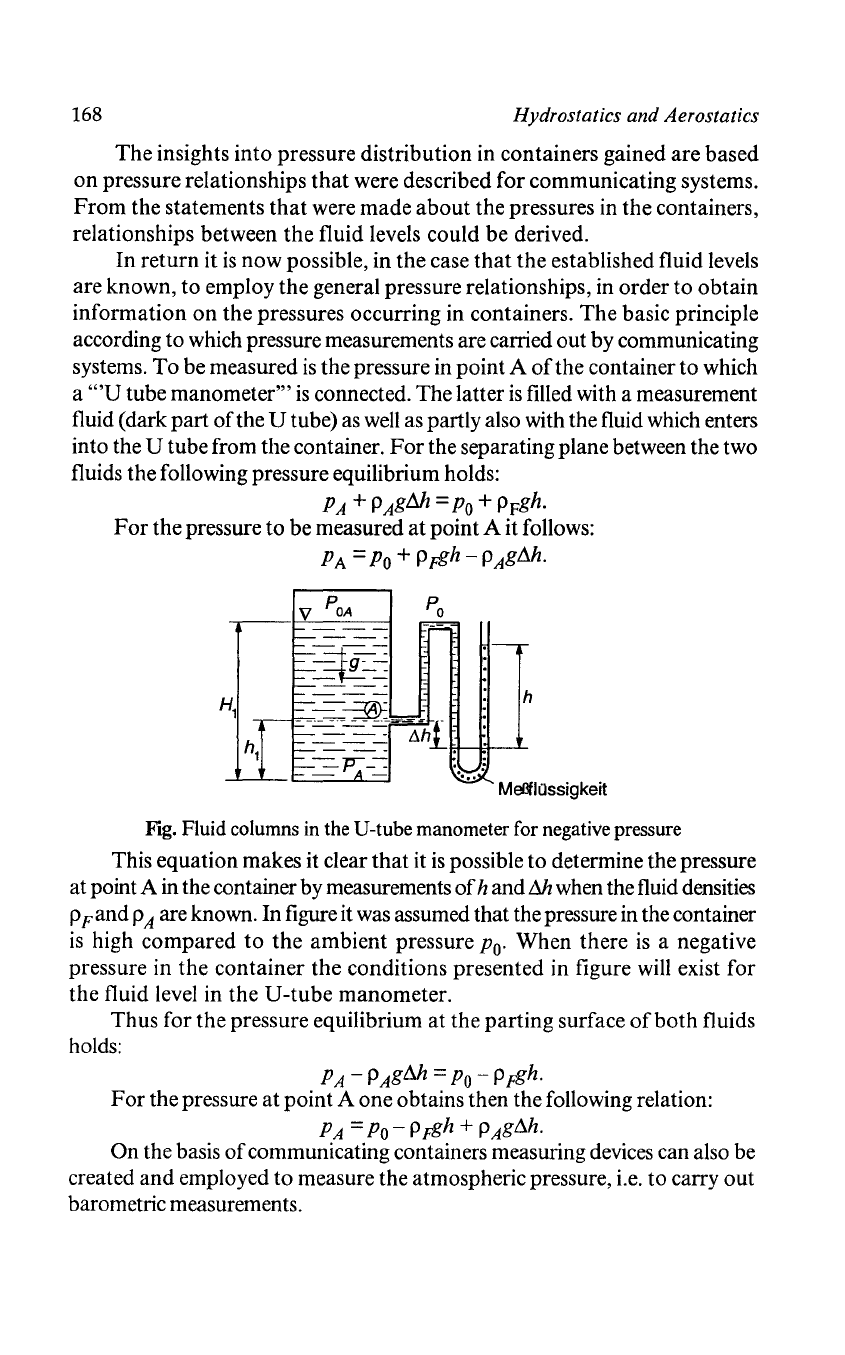
168
Hydrostatics and Aerostatics
The
insights into pressure distribution in containers gained are based
on
pressure relationships
that
were described for communicating systems.
From
the statements
that
were
made
about
the pressures in
the
containers,
relationships between
the
fluid levels could
be
derived.
In
return
it
is
now
possible, in
the
case
that
the
established fluid levels
are known,
to
employ
the
general pressure relationships, in order
to
obtain
information
on
the
pressures occurring in containers.
The
basic principle
according to which pressure measurements are carried out by communicating
systems.
To
be measured
is
the pressure in point A
ofthe
container
to
which
a
"'U
tube manometer'"
is
connected. The latter
is
filled with a measurement
fluid (dark
part
of
the U tube) as
well
as partly also with the fluid which enters
into the
U tube from the container.
For
the separating plane between the two
fluids the following pressure equilibrium holds:
P A + P
Agt:Jz
=
Po
+
PFg
h
.
For
the
pressure
to
be measured
at
point A it follows:
P A =
Po
+ P
~h
- P
Agt:Jz·
=ig=---~
~-
---
...
h
Malflassigkeit
Fig. Fluid columns in the V-tube manometer for negative pressure
This equation makes it clear
that
it
is
possible to determine the pressure
at point A in the container by measurements
of
hand
t:Jz
when the fluid densities
P
F and P A are known. In figure it was assumed that the pressure in the container
is
high
compared
to
the
ambient pressure
po.
When there
is
a negative
pressure in
the
container
the
conditions presented in figure will exist for
the
fluid level in
the
U-tube
manometer.
Thus
for
the
pressure equilibrium at the
parting
surface
of
both
fluids
holds:
P A - P
Agt'lh
=
Po
- P
Fg
h
.
F or the pressure at point A one obtains then the following relation:
P A =
Po
- P
~h
+ P
Agt'lh.
On
the basis
of
communicating containers measuring devices can also be
created
and
employed
to
measure the atmospheric pressure, i.e. to carry
out
barometric measurements.
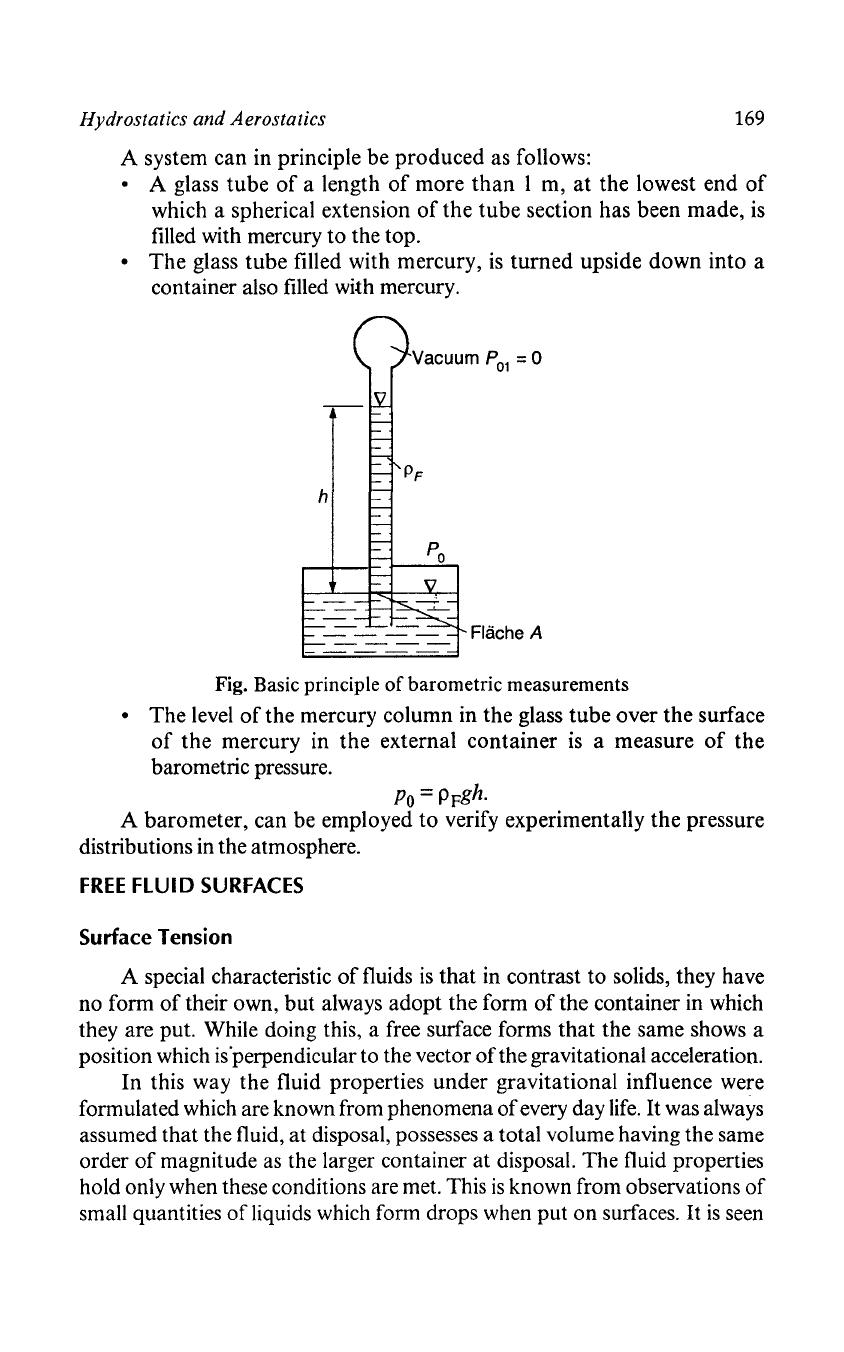
Hydrostatics and Aerostatics
169
A system can in principle be produced as follows:
• A glass
tube
of
a length
of
more
than
I m,
at
the lowest end
of
which a spherical extension
of
the
tube
section has been made,
is
filled with mercury to the top.
•
The
glass
tube
filled with mercury,
is
turned upside down into a
container also filled with mercury.
h
Flache A
-----
Fig. Basic principle
of
barometric measurements
• The level
of
the mercury column in the glass tube over the surface
of
the
mercury in the external container
is
a measure
of
the
barometric pressure.
Po
=
PFg
h
.
A barometer, can be employed
to
verify experimentally the pressure
distributions in the atmosphere.
FREE
FLUID
SURFACES
Surface Tension
A special characteristic
of
fluids
is
that
in contrast to solids, they have
no form
of
their own,
but
always adopt the form
of
the container in which
they are put. While doing this, a free surface forms
that
the same shows a
position which
is
·perpendicular to the vector
of
the gravitational acceleration.
In this way the fluid properties under gravitational influence were
formulated which are known from phenomena
of
every day
life.
It
was always
assumed that the fluid, at disposal, possesses a total volume having the same
order
of
magnitude
as
the larger container at disposal. The fluid properties
hold only when these conditions are met. This
is
known from observations
of
small quantities
of
liquids which form drops when put on surfaces.
It
is
seen
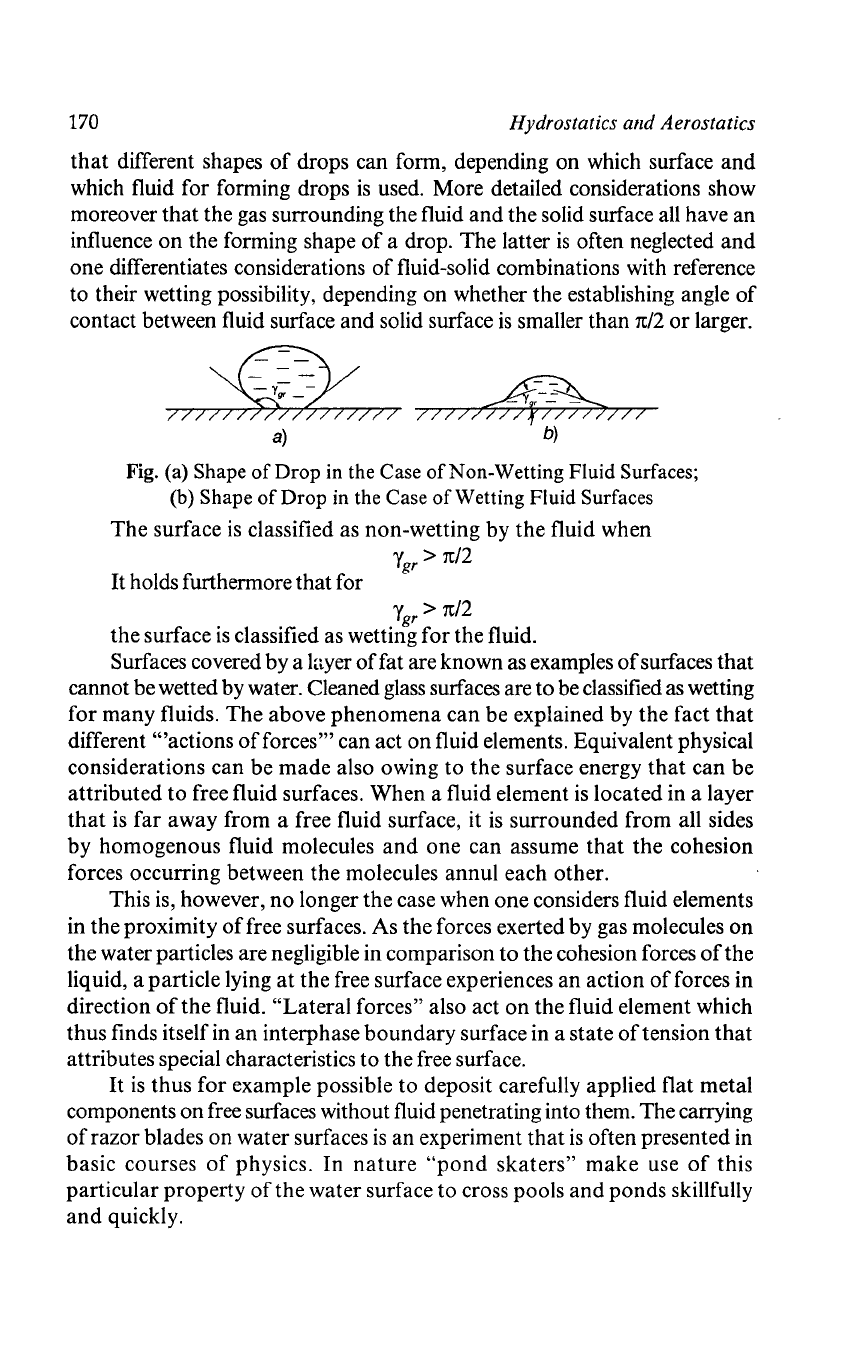
170
Hydrostatics and Aerostatics
that
different shapes
of
drops can fonn, depending on which surface
and
which fluid for forming drops
is
used. More detailed considerations show
moreover that the gas surrounding the fluid and the solid surface all have an
influence
on
the forming shape
of
a drop. The latter
is
often neglected
and
one differentiates considerations
of
fluid-solid combinations with reference
to their wetting possibility, depending on whether the establishing angle
of
contact between fluid surface and solid surface
is
smaller than nl2
or
larger.
777~777
17777~777
a)
b)
Fig. (a) Shape
of
Drop in the Case
of
Non-Wetting Fluid Surfaces;
(b) Shape
of
Drop in the Case
of
Wetting Fluid Surfaces
The
surface
is
classified as non-wetting by the fluid when
'Ygr>
nl2
It holds furthennore that for
'Ygr>
nl2
the surface
is
classified as wetting
for
the fluid.
Surfaces covered by a
layer
of
fat are known as examples
of
surfaces that
cannot be wetted by water. Cleaned glass surfaces are to be classified
as
wetting
for
many fluids.
The
above phenomena can be explained by the fact
that
different '''actions offorces'" can act on fluid elements. Equivalent physical
considerations can be
made
also owing to the surface energy
that
can be
attributed
to
free fluid surfaces. When a fluid element
is
located in a layer
that
is
far away from a free fluid surface, it
is
surrounded from all sides
by
homogenous fluid molecules
and
one can assume
that
the cohesion
forces occurring between the molecules annul each other.
This is, however,
no
longer the case when one considers fluid elements
in the proximity
of
free surfaces. As the forces exerted by gas molecules
on
the water particles are negligible in comparison
to
the cohesion forces
of
the
liquid, a particle lying
at
the free surface experiences an action offorces in
direction
of
the fluid. "Lateral forces" also act
on
the fluid element which
thus finds itself in an interphase
boundary
surface in a state
of
tension
that
attributes special characteristics
to
the free surface.
It
is
thus
for
example possible to deposit carefully applied flat metal
components on free surfaces without fluid penetrating into them. The carrying
of
razor blades on water surfaces
is
an experiment
that
is
often presented in
basic courses
of
physics.
In
nature
"pond
skaters"
make
use
of
this
particular property
of
the water surface to cross pools
and
ponds skillfully
and
quickly.
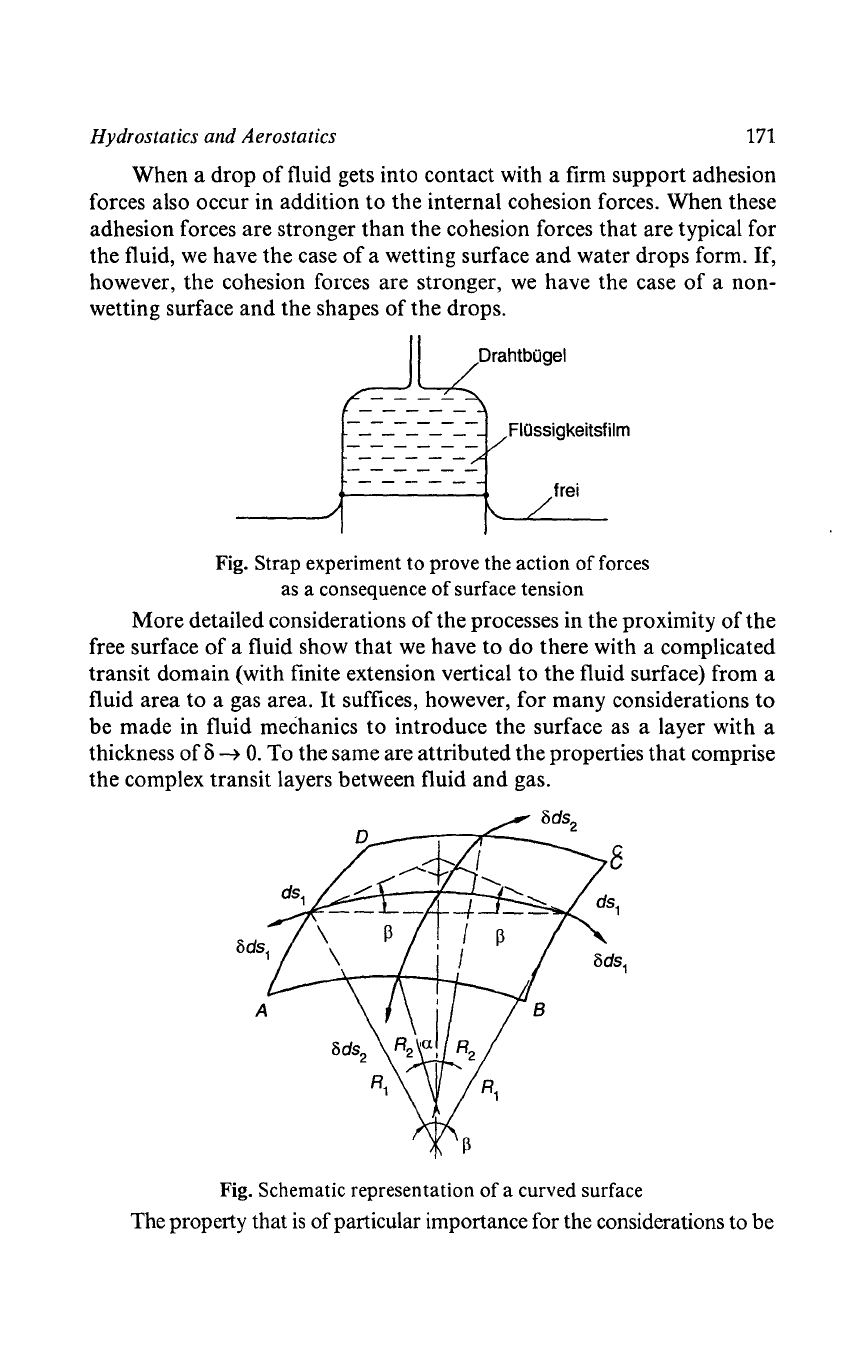
Hydrostatics and Aerostatics
171
When a drop
of
fluid gets into contact with a firm support adhesion
forces also occur in addition to the internal cohesion forces. When these
adhesion forces are stronger than the cohesion forces that are typical for
the fluid,
we
have the case
of
a wetting surface
and
water drops form. If,
however, the cohesion forces are stronger,
we
have the case
of
a non-
wetting surface
and
the shapes
of
the drops.
Drahtbugel
FIOssigkeitsfilm
frei
Fig. Strap experiment to prove the action
of
forces
as a consequence
of
surface tension
More detailed considerations
of
the processes in the proximity
of
the
free surface
of
a fluid show that
we
have to do there with a complicated
transit domain (with finite extension vertical to the fluid surface) from a
fluid area to a gas area.
It
suffices, however, for many considerations to
be made in fluid mechanics to introduce the surface
as
a layer with a
thickness
of
8
~
O.
To the same are attributed the properties that comprise
the complex transit layers between fluid and gas.
Fig. Schematic representation
of
a curved surface
The property that
is
of particular importance for the considerations to be
